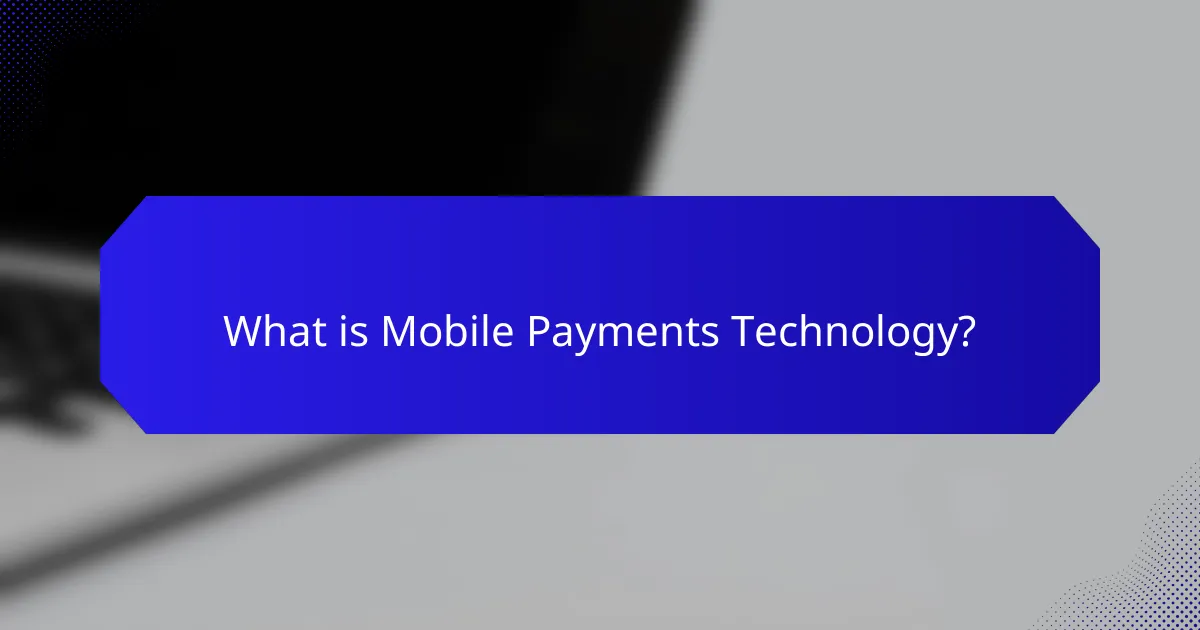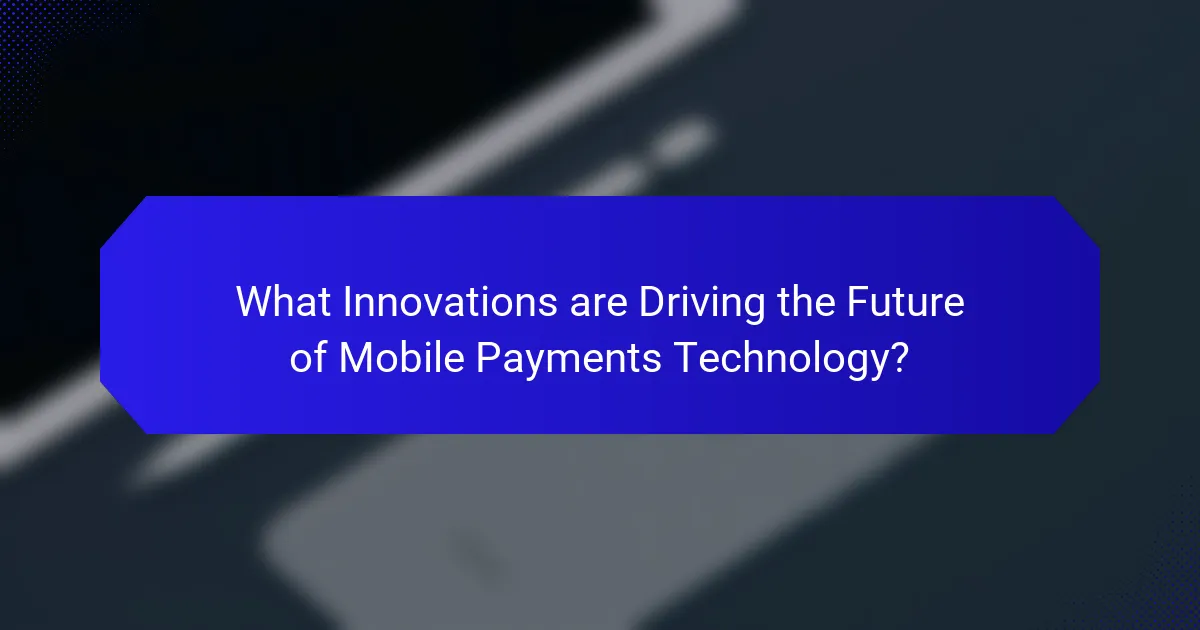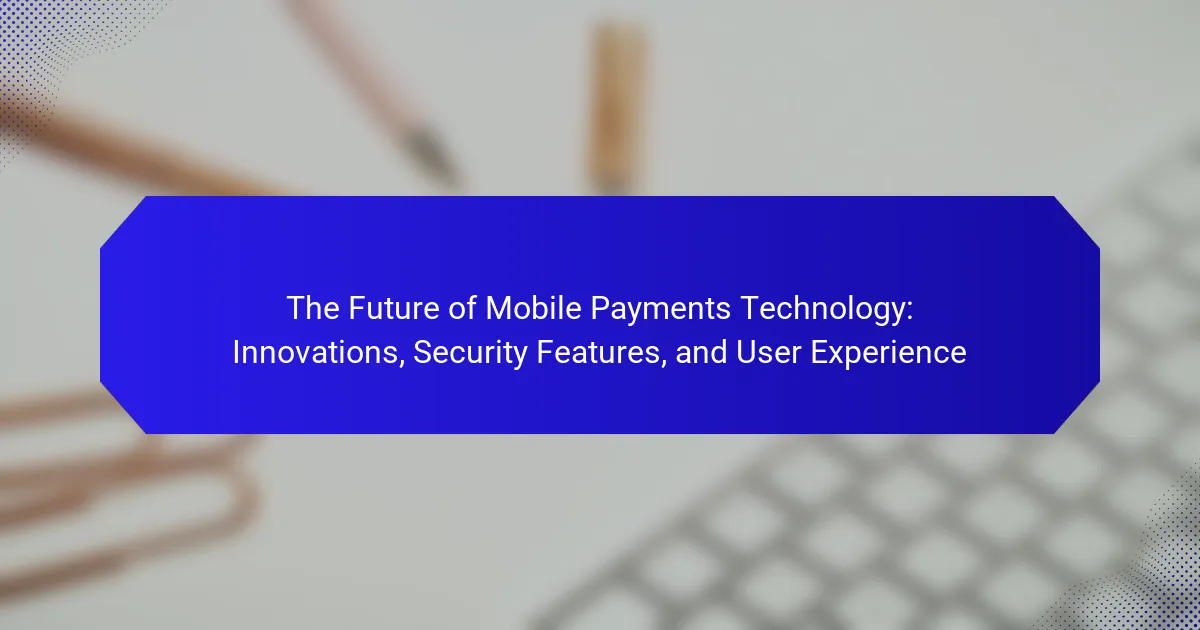Mobile payments technology facilitates financial transactions through mobile devices such as smartphones and tablets, utilizing methods like Near Field Communication (NFC) and QR codes. This article explores the projected growth of mobile payment transaction values, innovations driving the industry, and essential security features that enhance user trust. Key advancements include contactless payments, blockchain integration, and biometric authentication, which collectively improve transaction efficiency and security. Additionally, the article highlights the importance of user experience (UX) in mobile payment applications, emphasizing streamlined interfaces and real-time notifications that cater to consumer preferences for convenience and safety.

What is Mobile Payments Technology?
Mobile payments technology enables financial transactions using mobile devices. It allows users to make payments through smartphones or tablets, often via apps or digital wallets. This technology employs various methods, including Near Field Communication (NFC) and QR codes. According to Statista, mobile payment transaction value is projected to reach $12 trillion by 2025. The convenience and speed of mobile payments drive their growing adoption among consumers and businesses. Security features like encryption and biometric authentication enhance user trust. Overall, mobile payments technology represents a significant shift in how transactions are conducted in the digital age.
How does Mobile Payments Technology function?
Mobile payments technology functions by enabling transactions through mobile devices. It typically involves a combination of hardware and software components. Users initiate payments using mobile applications or digital wallets. These apps securely store payment information, such as credit card details. When a transaction is made, the device communicates with a payment terminal or online platform. This communication often utilizes Near Field Communication (NFC) or QR codes. The transaction is processed through a secure payment gateway. The payment gateway encrypts the data to protect sensitive information. This technology allows for quick and convenient transactions, enhancing user experience.
What are the key components of Mobile Payments Technology?
The key components of mobile payments technology include mobile devices, payment gateways, and security protocols. Mobile devices facilitate transactions through applications or digital wallets. Payment gateways process the transaction by connecting the merchant’s account to the customer’s payment method. Security protocols ensure the safety of sensitive information during transactions. These protocols include encryption and tokenization to protect data. Additionally, Near Field Communication (NFC) technology allows for contactless payments. User authentication methods, such as biometrics, enhance security further. Together, these components create a seamless and secure mobile payment experience.
How do these components interact to facilitate transactions?
Mobile payment transactions involve components like payment gateways, mobile devices, and security protocols. These components interact seamlessly to enable secure and efficient transactions. The payment gateway processes the transaction by connecting the user’s mobile device to the merchant’s account. Mobile devices serve as the medium for initiating transactions, allowing users to make payments easily. Security protocols protect sensitive data during the transaction process. Encryption techniques ensure that payment information remains confidential. Additionally, authentication methods verify the identity of the user before completing the transaction. Each component plays a crucial role in ensuring a smooth transaction experience. Together, they enhance user trust and promote the adoption of mobile payment technology.
What are the historical developments in Mobile Payments Technology?
Mobile payments technology has evolved significantly since its inception. The first mobile payment system was introduced in Japan in 2004 with NTT DoCoMo’s “i-mode” service. This service allowed users to make small transactions via their mobile phones. In 2007, Apple launched the iPhone, which paved the way for smartphone-based payments. Google Wallet followed in 2011, enabling NFC-based transactions. In 2014, Apple Pay was launched, popularizing mobile wallets in the U.S. The introduction of EMV chip technology in 2015 improved security for card transactions. By 2020, the COVID-19 pandemic accelerated the adoption of contactless payments globally. Today, mobile payments continue to innovate with features like biometric authentication and blockchain technology.
How has Mobile Payments Technology evolved over the years?
Mobile payments technology has significantly evolved from basic SMS transactions to advanced contactless payments. Initially, mobile payments relied on SMS or WAP for transactions, which were limited and not widely adopted. The introduction of Near Field Communication (NFC) in smartphones around 2011 enabled contactless payments, increasing user convenience. Major tech companies like Apple and Google launched mobile wallets, such as Apple Pay and Google Wallet, enhancing security through tokenization. The rise of QR code payments in markets like China demonstrated an alternative method for transactions, allowing users without NFC-enabled devices to participate. Additionally, advancements in biometric authentication, such as fingerprint and [censured] recognition, have improved security and user experience. By 2020, global mobile payment transactions surpassed $1 trillion, showcasing widespread adoption and integration into daily commerce. This evolution reflects a shift towards seamless, secure, and user-friendly payment solutions.
What milestones have shaped the current state of Mobile Payments Technology?
The current state of Mobile Payments Technology has been shaped by several key milestones. The introduction of Near Field Communication (NFC) technology in smartphones enabled contactless payments. In 2011, Google Wallet launched, marking a significant step in mobile payment applications. Apple Pay followed in 2014, popularizing mobile payments among consumers. The rise of digital wallets like PayPal and Venmo further expanded user adoption. In 2020, the COVID-19 pandemic accelerated the shift towards contactless payments due to health concerns. The integration of biometric authentication enhanced security features in mobile payments. These milestones collectively transformed how consumers engage with financial transactions.

What Innovations are Driving the Future of Mobile Payments Technology?
Innovations driving the future of mobile payments technology include contactless payments, blockchain integration, and biometric authentication. Contactless payments allow users to complete transactions quickly through NFC technology. This method has gained popularity, with a 150% increase in contactless transactions from 2019 to 2020. Blockchain integration enhances security and transparency in transactions. It reduces fraud and enables faster settlement times. Biometric authentication, such as fingerprint and [censured] recognition, improves user security and convenience. According to a 2022 report by Juniper Research, biometric payments are expected to account for over 50% of mobile transactions by 2025. These innovations collectively enhance the efficiency and security of mobile payment systems.
How are emerging technologies influencing Mobile Payments?
Emerging technologies are significantly influencing mobile payments by enhancing security, improving user experience, and enabling faster transactions. Technologies like blockchain provide decentralized security, reducing fraud risks. Biometric authentication methods, such as fingerprint and [censured] recognition, enhance user verification. Near Field Communication (NFC) technology allows for quick and seamless transactions. Artificial intelligence is being used to analyze spending patterns and detect fraudulent activities in real-time. According to a report by Juniper Research, mobile payment transactions are expected to exceed $4.5 trillion globally by 2023, showcasing the impact of these technologies. The integration of 5G networks further accelerates transaction speeds, making mobile payments more efficient. Overall, these innovations are reshaping the mobile payment landscape, driving widespread adoption and consumer confidence.
What role does artificial intelligence play in Mobile Payments?
Artificial intelligence enhances mobile payments by improving transaction security and user experience. AI algorithms analyze transaction data to detect fraudulent activities in real-time. According to a report by Juniper Research, AI can reduce fraud-related losses by up to 50%. Additionally, AI personalizes user experiences through tailored payment solutions. Machine learning models predict user preferences, streamlining the payment process. AI also automates customer service through chatbots, providing instant assistance. This increases user satisfaction and engagement. Overall, AI plays a crucial role in making mobile payments more secure and user-friendly.
How is blockchain technology impacting Mobile Payments?
Blockchain technology is significantly enhancing mobile payments by providing increased security and transparency. It allows for secure peer-to-peer transactions without intermediaries. This reduces transaction costs and speeds up processing times. Blockchain’s decentralized nature minimizes fraud risk. According to a report by the World Economic Forum, blockchain can reduce payment processing times from days to seconds. Additionally, it enables programmable money features, allowing for smart contracts in transactions. This innovation can streamline processes and improve user experience. Overall, blockchain is transforming the mobile payments landscape by making it more efficient and secure.
What new features are being introduced in Mobile Payments Technology?
Mobile payments technology is introducing features such as biometric authentication, enhanced security protocols, and integration with digital wallets. Biometric authentication uses fingerprints or [censured] recognition for secure transactions. Enhanced security protocols include tokenization and end-to-end encryption to protect user data. Integration with digital wallets allows users to store multiple payment methods in one app. Additionally, contactless payments are becoming more prevalent, enabling faster transactions. These innovations aim to improve user experience and security in mobile transactions. According to a report by Statista, the global mobile payment market is projected to reach $12.06 trillion by 2025, highlighting the significance of these advancements.
How are biometric security features enhancing user experience?
Biometric security features enhance user experience by providing quick and secure authentication methods. These features include fingerprint scanning, [censured] recognition, and iris scanning. They eliminate the need for passwords, which can be forgotten or compromised. According to a study by the National Institute of Standards and Technology, biometric systems can reduce transaction time by up to 50%. Users benefit from the convenience of seamless access to their devices and applications. Enhanced security also increases user trust in mobile payment systems. As a result, adoption rates for mobile payments continue to rise, driven by user satisfaction with biometric technologies.
What advancements in user interface design are being implemented?
Advancements in user interface design include the integration of voice user interfaces, gesture controls, and augmented reality. Voice user interfaces allow users to interact through speech, enhancing accessibility. Gesture controls enable touchless navigation, improving user experience in mobile payments. Augmented reality overlays information in real-time, facilitating intuitive interactions. These advancements aim to streamline processes and enhance user engagement. Research shows that 72% of users prefer voice commands for tasks, indicating a shift towards more natural interactions.

What Security Features are Essential for Mobile Payments Technology?
Essential security features for mobile payments technology include encryption, tokenization, biometric authentication, and secure element storage. Encryption protects sensitive data during transmission. Tokenization replaces sensitive information with unique identifiers, reducing the risk of data breaches. Biometric authentication, such as fingerprint or [censured] recognition, ensures that only authorized users can access payment functions. Secure element storage keeps cryptographic keys and sensitive data isolated from the main operating system. According to the Federal Trade Commission, these features significantly reduce fraud and enhance consumer trust in mobile payment systems.
How do security measures protect users in Mobile Payments?
Security measures protect users in mobile payments by implementing encryption, authentication, and fraud detection technologies. Encryption secures sensitive data during transmission, making it unreadable to unauthorized parties. Authentication verifies the identity of users through methods like biometrics or two-factor authentication. Fraud detection systems monitor transactions for unusual patterns, alerting users and preventing unauthorized access. According to a report by the Federal Reserve, 75% of mobile payment users feel secure due to these measures. This combination of technologies significantly reduces the risk of data breaches and financial loss, enhancing overall user confidence in mobile payment systems.
What are the most common security threats to Mobile Payments?
The most common security threats to mobile payments include malware, phishing attacks, and data breaches. Malware can infect devices, allowing cybercriminals to steal payment information. Phishing attacks trick users into providing personal data through fake communications. Data breaches occur when unauthorized access exposes sensitive payment information. According to a 2022 report by the Identity Theft Resource Center, data breaches increased by 68% from the previous year. This highlights the growing risks associated with mobile payment systems. Additionally, insecure Wi-Fi networks can expose users to man-in-the-middle attacks, compromising transaction security.
How do encryption and tokenization safeguard transactions?
Encryption and tokenization safeguard transactions by protecting sensitive data during transfer and storage. Encryption converts data into a coded format that can only be accessed with a decryption key. This ensures that even if data is intercepted, it remains unreadable to unauthorized users. Tokenization replaces sensitive data with unique identification symbols, or tokens, that retain essential information without compromising security. This means that even if a token is stolen, it cannot be used to access the original data. Together, these methods significantly reduce the risk of data breaches and fraud in mobile payment systems. According to a report by the Ponemon Institute, organizations that implement encryption and tokenization see a 50% reduction in data breaches.
Why is user trust critical for the success of Mobile Payments?
User trust is critical for the success of mobile payments because it directly influences user adoption and transaction frequency. Consumers are more likely to use mobile payment systems if they feel secure about their personal and financial information. A study by PwC found that 62% of consumers are concerned about data privacy when using mobile payment apps. Trust in security measures, such as encryption and biometric authentication, enhances user confidence. Additionally, positive user experiences contribute to word-of-mouth recommendations, further driving adoption. Without trust, mobile payment platforms risk lower usage rates and higher abandonment during transactions.
What factors influence user trust in Mobile Payments Technology?
User trust in Mobile Payments Technology is influenced by several key factors. Security features are paramount; users need assurance that their financial data is protected. According to a study by the Pew Research Center, 81% of Americans feel that the potential risks of data collection by companies outweigh the benefits. User experience also plays a crucial role; a seamless and intuitive interface encourages trust. Transparency in transaction processes builds confidence, as users prefer to understand how their data is used. Additionally, brand reputation significantly impacts trust; established brands with a history of reliability are more likely to be trusted. Customer support availability further enhances user trust; quick and effective resolution of issues fosters confidence in the technology.
How can companies enhance trust and security perception?
Companies can enhance trust and security perception by implementing robust security measures. This includes using encryption protocols to protect sensitive data during transactions. Regular security audits help identify and rectify vulnerabilities. Transparent communication about security practices builds customer confidence. Offering two-factor authentication adds an extra layer of protection. Educating users about safe practices further fosters trust. According to a study by the Ponemon Institute, 70% of consumers prioritize security when choosing payment methods. This highlights the importance of perceived security in customer decision-making.

How is User Experience (UX) being Enhanced in Mobile Payments Technology?
User Experience (UX) in mobile payments technology is being enhanced through streamlined interfaces and improved security features. Simplified app designs allow for quicker transactions, reducing user frustration. Biometric authentication, such as fingerprint and [censured] recognition, increases security while maintaining convenience. Contactless payment options further speed up the checkout process. Integration with digital wallets consolidates multiple payment methods for ease of use. Real-time notifications keep users informed about transactions, enhancing transparency. User feedback mechanisms within apps help developers make continuous improvements. According to a 2022 study by McKinsey, 75% of users prefer mobile payment apps that prioritize user-friendly design and security.
What are the key elements of a good user experience in Mobile Payments?
A good user experience in mobile payments includes several key elements. These elements are usability, security, speed, and accessibility. Usability ensures that the interface is intuitive and easy to navigate. Security involves robust measures to protect user data and transactions. Speed refers to the quick processing of payments, minimizing wait times. Accessibility ensures that the payment system is usable for people with varying abilities. According to a study by the Pew Research Center, 79% of smartphone users have made a mobile payment, highlighting the importance of these elements in user satisfaction and adoption.
How do usability and accessibility impact Mobile Payments?
Usability and accessibility significantly impact mobile payments by enhancing user experience and broadening market reach. Usability refers to how easily users can navigate and complete transactions within a mobile payment app. A study by Nielsen Norman Group found that user-friendly interfaces can increase transaction completion rates by up to 50%. Accessibility ensures that individuals with disabilities can also utilize mobile payment systems. According to the World Health Organization, over 1 billion people live with disabilities, highlighting the necessity for inclusive design. Mobile payment platforms that prioritize usability and accessibility can attract a larger user base and foster customer loyalty.
What feedback mechanisms are used to improve Mobile Payments UX?
User feedback mechanisms enhance Mobile Payments UX through surveys, usability testing, and customer support interactions. Surveys gather user opinions on app functionality and satisfaction. Usability testing observes real users navigating the app to identify pain points. Customer support interactions provide insights into common issues and user concerns. Analytics track user behavior, revealing trends and areas for improvement. A/B testing evaluates changes in design or features based on user responses. These mechanisms collectively inform developers on how to refine the user experience effectively.
What best practices can enhance the user experience in Mobile Payments?
To enhance the user experience in mobile payments, prioritize simplicity and speed. Users prefer a streamlined checkout process that minimizes steps. Implement biometric authentication for secure and quick access. Ensure the interface is intuitive and easy to navigate. Offer multiple payment options to cater to diverse user preferences. Provide clear feedback during transactions to reassure users. Optimize for mobile devices, ensuring responsiveness across different screen sizes. Regularly update the app to fix bugs and improve performance. According to a study by Statista, 75% of users abandon mobile transactions due to poor user experience.
How can companies implement user-centered design in Mobile Payments?
Companies can implement user-centered design in mobile payments by prioritizing user research and testing. This involves gathering insights directly from users about their needs and preferences. Companies should conduct usability testing to identify pain points in the payment process. Iterative design practices allow for continuous feedback and improvement based on user interactions.
Additionally, incorporating accessibility features ensures inclusivity for all users. A focus on intuitive interfaces can enhance user experience significantly. Data from the Nielsen Norman Group indicates that usability improvements can lead to increased user satisfaction and retention. By using analytics, companies can track user behavior and adapt their designs accordingly. This data-driven approach ensures that the mobile payment solutions remain relevant and user-friendly.
What tips can users follow to optimize their Mobile Payments experience?
To optimize their mobile payments experience, users should ensure their devices are updated regularly. Regular updates enhance security and functionality. Users should also enable biometric authentication for added security. This feature provides a quick and secure way to authorize transactions.
Additionally, users must choose reputable payment apps. Trusted apps have better security measures in place. Users should also monitor their transaction history regularly. This practice helps identify any unauthorized transactions promptly.
Lastly, users should connect to secure Wi-Fi networks only. Public Wi-Fi can expose sensitive information to threats. Following these tips can significantly enhance the mobile payments experience.
Mobile payments technology represents a transformative approach to financial transactions using mobile devices, enabling users to make payments through smartphones and tablets. This article explores the evolution of mobile payments, highlighting key components such as payment gateways, security protocols, and the role of emerging technologies like blockchain and artificial intelligence. It also examines innovations driving the future of mobile payments, including biometric authentication and contactless transactions, while addressing essential security features that enhance user trust. Finally, the article discusses the importance of user experience (UX) in mobile payments, focusing on usability, accessibility, and feedback mechanisms that improve overall satisfaction.
